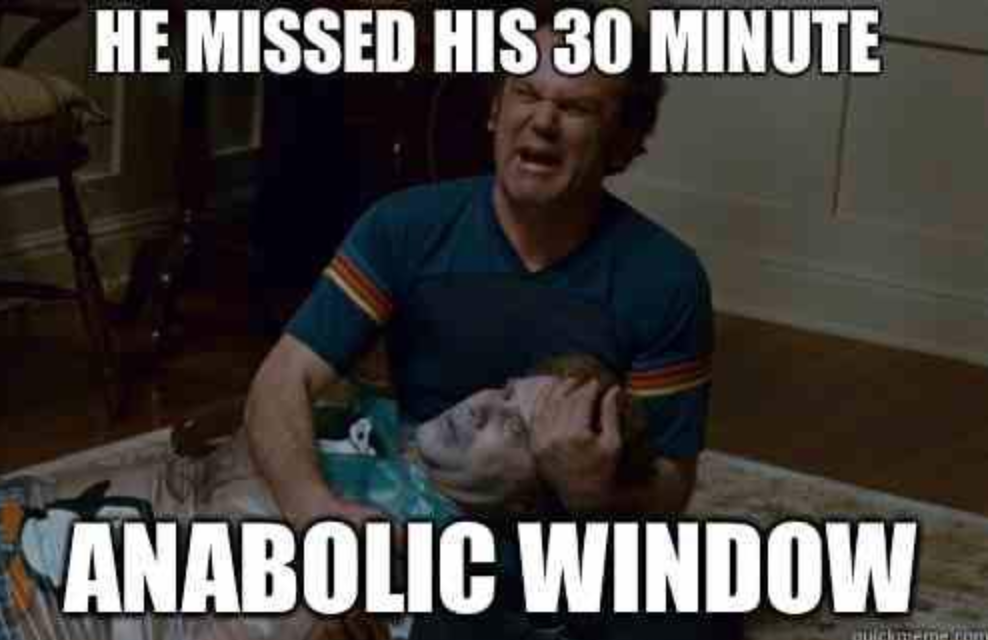“I Exercise in the Morning, Can I Do Intermittent Fasting?”
In this article, I hope to dispel some myths around post workout nutrition and give my top tips on how to incorporate Intermittent Fasting and the 2 Meal Day into your morning training routine. I often find myself having to clarify the truth behind a lot of Intermittent Fasting myths as so many are being pushed around all too often. These myths can have considerable effects on not only whether people choose to do Intermittent Fasting or not, but also whether they end up doing it safely!
GET MY INTERMITTENT FASTING SHORT COURSE
The Anabolic Window
In order for you to get the most of this article, you will need to understand something known as the “Anabolic Window”.
It refers to a time period after a workout, where your muscles are primed for growth as long as a suitable protein/carbohydrate source is consumed.
There has been a big emphasis on this window being as small as thirty minutes with supplement companies promoting the benefits and convenience of their rapidly digested products.
Does the anabolic window exist or is it just an overhyped marketing ploy?
The answer to this question is yes and no…it all depends on your goals, activity levels and training experience levels.
What does this mean for you?
If you are fairly inexperienced, with a few hour-long sessions per week for general fitness and your focus isn’t on performance, then as long as you eat enough quality protein/carbs at some point in the day, the timing of when you do is unimportant.
Whereas if you are someone whose sole focus is on performance with the aim of competing and you often find yourself training 5/6 times per week for 2 hours at a time, then the timing of your protein/carbs intake becomes a bit more important.
However, it has been shown that consuming a mix of protein and carbohydrates at either 1 hour or 3 hours post-exercise elicits the same response in regard to muscle protein synthesis, completely dispelling the suggestion that there is an anabolic window lasting only 30 minutes.
Intermittent Fasting and Muscle Growth
Intermittent fasting makes it easier to stay in a calorie deficit, which is why it is such an effective fat loss tool. However, if your main priortiy is muscle gain, then intermitent fasting can make it harder.
To gain muscle, you need to be lifting heavy weights, eating in a calorie surplus, and upping your protein intake.
I advise my clients who are focused on muscle gain to consume a protein shake with water around 1-3 hours after their early morning session.
Protein shakes can make it easier to get the right amount of protein in. If you think you can get all the protein you need in a 8-10 hour eating window, then the protein shake might not be needed.

How to incorporate the intermittent fasting if you exercise in the morning
If you belong in the less experienced, training for general fitness and weight loss group then you can exercise first thing in the morning and can continue to follow your Intermittent Fasting program until your lunchtime, as long as you get enough quality food in at your two meals. If you do this, there is no need to worry!
I might suggest consuming some electrolytes before training. This will help with hydration. An easy way to do this is to add a pinch of salt to 500ml of water an drink that before training.
Or, get yourself some salt tablets.
For those that are more experienced and have a big focus on performance (I am in this category), the best way to benefit from both exercising in the morning and following your Intermittent Fasting program is to experiment with your fasting hours and eating window. For example, if you are training first thing in the morning at 7am, aiming to eat about three hours after you finish your workout, you could have your dinner the night before a bit earlier and break your fast around 11am the next day.
This is purely anecdotal and won’t apply to everyone, last year I trained for my first ultra-marathon. Everyone knows that an increase in running is meant to decrease muscle mass and strength levels. However, I am followed a very specific program that was aimed at retaining my muscle mass and strength levels in conjunction with increasing my mileage every week.
During training, I actually put on weight (muscle), I continued to follow the 2 Meal Day and three of my 6 weekly exercise sessions were fasted, first thing in the morning and I continue to fast until lunchtime.
What does this mean? It means that if you are following the right training program and eating enough nutrient dense foods at some point in the day, you are good to go!
Summary
how should you be exercising in the morning and fasting?
The answer to this question is going to be different for everyone.
You are going to have to work out what your goals are and what you can incorporate into your training regime. Despite claims that immediate post-exercise nutritional intake is essential to maximize muscle gains, evidence-based support for such an “anabolic window of opportunity” is far from definitive.
It comes down to self-experimentation and what is realistic for you.
If you are concerned that you aren’t getting the right amount of food in, try tracking your calories so that you know for sure.
Read Next:
Intermittent Fasting vs. Keto – Which is Better?
How to Reset Your Body to Burn Fat
What is the 2 Meal Day and Why is it the Most Effective Method of Intermittent Fasting?
